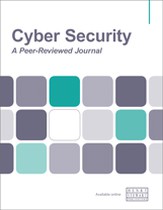A modern approach to cyber threat protection: The holy grail of cyber security departments?
Abstract
Cyber security is not only a hot topic debated intensely among business managers, but also a growing concern that enforces unplanned and often undesirable changes. Too tight security measures usually result in a spike in customer complaint volumes; too slack cause a lot of grey hair, especially after a breach. Continuously accelerating growth in number of IT applications, proliferation of various types of devices, software versions, channels and endpoints are significantly increasing the surface area of potential attacks. For professionals with strong links with the world of finance and security, it comes as no surprise that the old approaches are rapidly becoming obsolete. In many cases they cannot handle new challenges, not to mention elaborate and constantly evolving sociological theft strategies. New approaches are desperately sought. The hunt for the holy grail in a cyber security area has been on for quite some time now — apparently without a clear conclusion, as cybercrime is on the rise, regardless of the industry or geographical region. Data leaks and account takeovers have become daily news stories that many people pay attention to. This is why decision makers are exploring different approaches to security by venturing into new territories that were previously not purely classified as directly connected with security issues. Yet, if we want to ensure our clients’ finances, data and interests are appropriately protected, surely all options should be considered? This paper aims to shift the way managers view security in their institutions by highlighting alternative ways of approaching the subject. By incorporating into security interconnected and interdependent layers of verification mechanisms, higher fraud/takeover detection rates can be achieved without affecting usability. Readers will gain complex insights as to how these layers behave and how they operate within the financial institutions.
The full article is available to subscribers to the journal.
Author's Biography
Dariusz Trocyszyn Dariusz P. Trocyszyn has over 15 years’ experience in banking and banking consultancy, spanning Europe, the Middle East and South-East Asia. He holds a degree in banking and specialises in banking control and internal audits. Dariusz acts as a speaker at various financial venues, primarily The Asian Banker in Singapore. At Comarch, he co-creates small and medium enterprise (SME)/corporate ecosystems, drafts and consults on plans for digital transformation for international banks. He is recognised as a skilled team player, with in-depth business acumen supporting the implementation efforts of new generation SME/corporate banking platforms.
Adrian Korczyński is a cyber security professional with 15 years’ experience. Starting as a developer, he has designed and created systems for encryption, identity management, authentication and privileged session management. Throughout the years he has successfully delivered solutions for banking, telecommunications, public and healthcare sectors. His fields of expertise cover software, hardware, IT architecture, networking and management. Adrian is currently a director of Comarch’s Cyber Security Business Unit, dedicated to delivering cyber security solutions and services across the globe.
